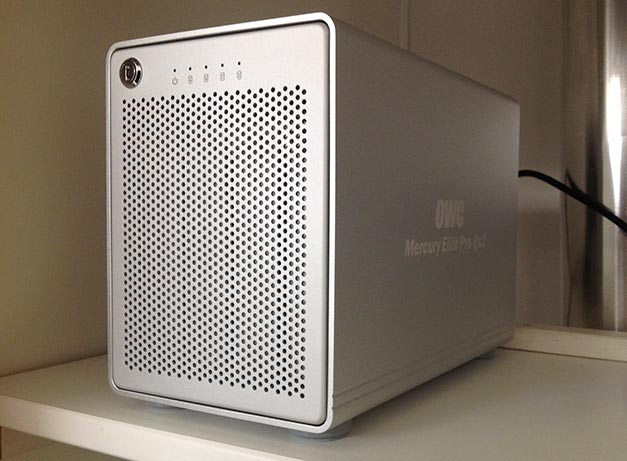As you might have heard, Thunderbolt is the new and promising computer interface for audio preamps and interfaces like Avid’s HD Native, Universal Audio’s Apollo and Apogee’s Symphony. But not just for interfaces. Its fantastic speed and daisy chaining options make it an ideal external storage solution. There’s only one problem. It is still rather pricey! That’s why I thought it would be interesting to test a USB 3 RAID system. In this review I’ll be looking at the OWC Mercury Elite Pro Qx2 USB 3 RAID system to see if it can be a viable alternative for Thunderbolt as a pro audio RAID system.
Unless you have plenty of dollars or euro’s to spare, Thunderbolt is an expensive solution for storage. It is slowly becoming cheaper but it will take a while before Thunderbolt is mainstream affordable. That is if it will ever become mainstream. Some feel it will end up like Firewire as a niche market solution. The fact that it is still mainly a Mac only option is not a positive sign. There are some PC’s that come with Thunderbolt ports but you can count them on one hand. Plus, not a lot of developers are yet supporting their hardware with drivers for PC. Many Thunderbolt audio interfaces for example lack PC support. This and Thunderbolt’s relative high price is holding back large scale adoption.
The technology though is far superior to anything out there at the moment. The fact that you can daisy chain up to six different devices on one port is extremely efficient and user friendly. But that price is a bottleneck. There’s good hope though that Thunderbolt will make it. Intel has shown it is serious about the technology by upgrading its specifications recently with the release of Thunderbolt 2 with 20 Gigabit per second transfer speeds. Plus the rather expensive Thunderbolt cables have recently seen a price drop by as much as 30 to 50 percent. Many developers develop new Thunderbolt hardware in a rapid tempo. These are all promising signs so let’s hope for a breakthrough in price and the growth of its user base.
Even so, Thunderbolt is not the only solution. There is an alternative for audio professionals that own a PC or one of the latest Macs and have a need for fast storage solutions. Thunderbolt’s main competitor is USB 3. It is much cheaper for developers to implement and has been around longer resulting in a more widespread use and available hardware. Almost all latest Macs have USB 3 connections. It is strange though that, as far as I know, there are no pro audio interfaces that use a USB 3 connection. They all still use USB 2. But the question is, is USB 3 good enough for high speed audio data transfer? What about that USB CPU cycle latency you might have heard about?
The USB 1 and USB 2 protocols have a high instruction CPU cycle time, where the time between an instruction from the computer and the response from the device is large. This gives a latency in the data packet stream, especially if you want to read and write at the same time. The USB 3 protocol though has received an overhaul and its instruction cycle response time is much better. It still has a larger latency compared to Thunderbolt but due to its high 4.8 Gb/s transfer speed, USB 3 is actually a good alternative. Especially if you use a RAID system.
I purchased the Mercury Elite Pro Qx2 from OWC and will tell you about my experience of using it in combination with the new Mac Pro and Pro Tools 11. The Mercury Elite Pro QX2 is a four 3.5 inch hard disk RAID enclosure. You can buy it either with hard drives pre installed or as an empty enclosure and put in your own drives. I opted for the latter as I migrated from an older Mac Pro that already had many drives installed. Those drives weren’t identical and since the Qx2 requires identical size and model hard drives for proper RAID performance, I am using it in Independent mode for now. This is also known as JBOD (Just a Bunch Of Disks). Independent mode mounts the individual drives just like I had it in my previous Mac Pro. I will eventually buy sets of identical hard drives and use the system in RAID 5 mode.
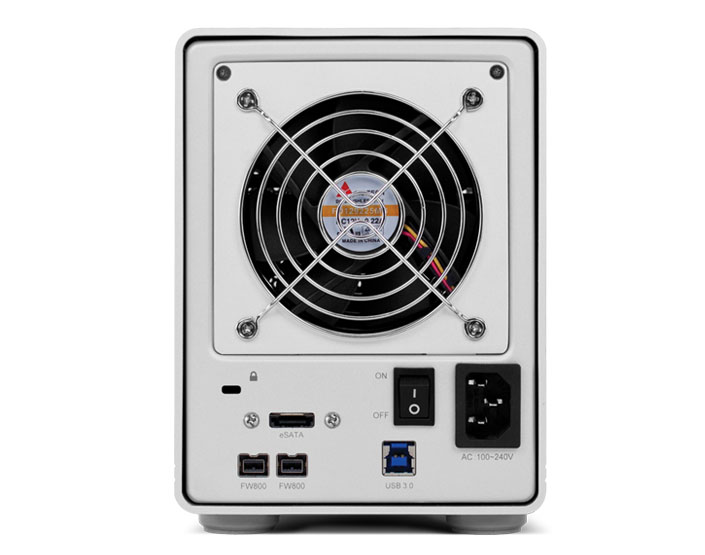
The latest incarnation of the Qx2 comes with eSATA, Firewire 800 and USB 3 connections on the back. I am testing the Qx2 with USB 3. If you would want to you can still connect it to a Thunderbolt port by buying the Lacie eSata to Thunderbolt hub. A large fan on the back cools the drives by sucking out the hot air. The temperature isn’t monitored so the fan always rotates at a ‘safe cooling’ speed. Unfortunately this results in a noticeable amount of noise. The noise is pretty constant and without any resonance. Still, if you are working in a project or bedroom studio where you also do your recording you might want to think twice about the Qx2. Especially if you don’t have an isolated machine room/cabinet. I’m a tiny bit disappointed about the noise of the Qx2 as the new Mac Pro is so incredibly quiet. The Qx2 more than doubles the noise floor. Together though this system is still quieter than my old Mac Pro and I do have an isolated cabinet so it is not such a big issue. But I loved to open the cabinet and let people hear how silent my recording hardware setup was when I had my drives in external passive cooling enclosures. Ah well, you can’t have it all.
The Qx2 is solidly build and easy to set up. The front of the Qx2 can be detached with a key revealing four drive bays. Taking out a bay is as simple as turning a screw by hand and slide it out by pulling it towards you. The bay slide fits neatly around a SATA harddisk and is attached with four small screws that come with the Qx2 for all four bays.
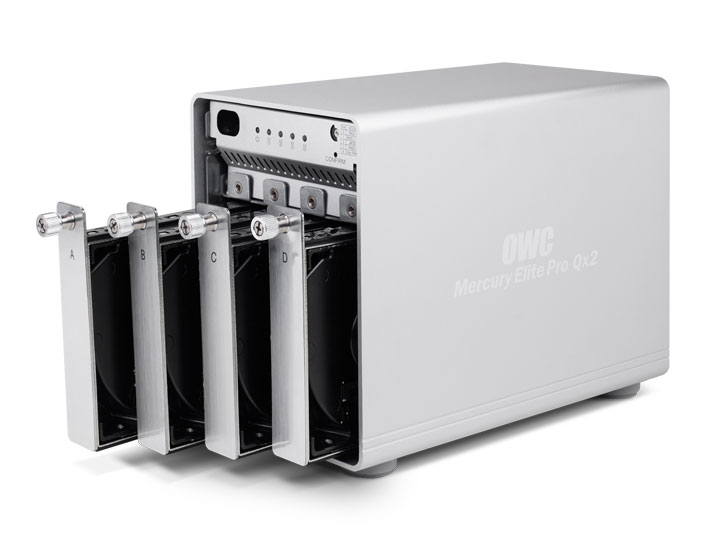
A small switch on the front of the Qx2 allows you to set the RAID mode that can vary between RAID 0, 1, 5, 10, Span and JBOD/Independent mode. An overview and explanation of the different RAID modes can be found on OWC’s website.
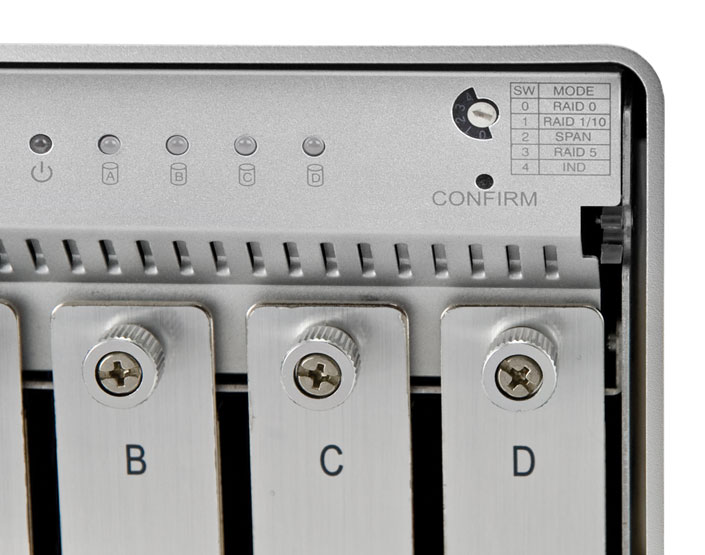
As said earlier, for proper RAID performance OWC strongly advices you to use matched identical drive brands and sizes in the Mercury Pro Qx2. The same page for the RAID modes mentioned above also has a link with an overview of the drive types and brands that OWC claims to work best. There are two drives that OWC is strongly recommending against using. These are the Seagate Barracuda 7200.11 series (other Barracudas are fine it’s just the 11 series) and the Western Digital Green series. The latter I can fully agree with from first hand experience. I had three WD Green drives that I used as Time Machine backup drives and they all broke down within two years of use giving me bad block errors. Their controller regulates the drive’s speed and brings it down when the drive is idle. The WD Green drives are meant for long term backup storage and not for day to day use in a RAID setup.
Unfortunately all drives in my old Mac Pro were of different brands so I couldn’t properly test the RAID performance. I still tested two 1 TB drives (WD Caviar Black and Samsung) in a RAID 1 setup just to see what kind of read and write speeds it would offer. The Black Magic Design speed test software gave me a nice 288 MB/s read and 264 MB/s write speed. Which is not bad and perfectly usable for large session audio recording.
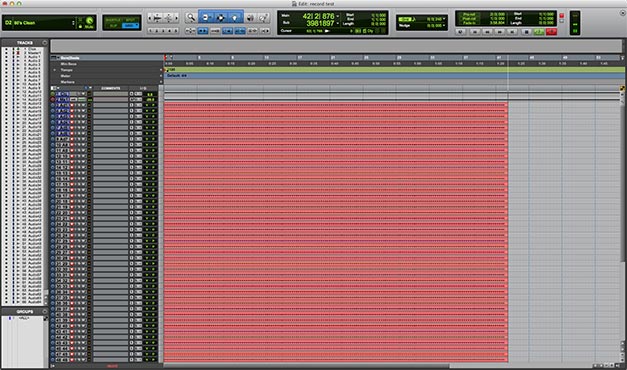
But as different drive brands are not recommended I put the Qx2 in JBOD (Just a Bunch Of Disks) or independent mode in which it also showed good read and write speeds. Using Pro Tools 11 HD (with the disk cache function OFF) I continuously recorded 64 audio tracks to a single drive in the Qx2. The disk meter showed 11 percent of usage during recording and 16 percent during playback (see picture). This means the USB 3 bus in the new Mac Pro is doing a fine job of transferring the data to and from the Mercury Elite Pro Qx2 RAID enclosure. Not once did I experience a hiccup or a strange spike in disk usage.
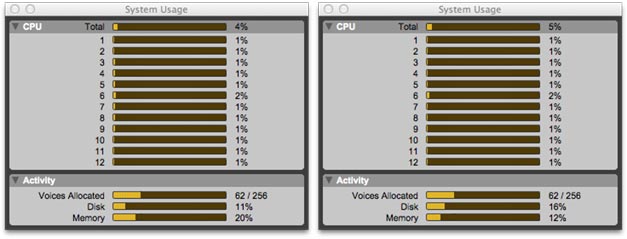 Disk usage during recording and playback to the OWC Mercury Elite pro USB 3
Disk usage during recording and playback to the OWC Mercury Elite pro USB 3
Time will tell how the Qx2 performs in RAID mode when a drive breaks down, as no drives were harmed during testing 😉 so I can’t give a full review. Let me give one word of advice though. When a RAID system with the right protocol breaks down you should be protected from data loss by swapping out the bad drive and putting in an identical new one. This is great and all but a RAID system is by no means a guarantee that you will not lose any data. Always, and I repeat, always backup your precious data residing on your RAID system onto another drive or multiple drives. This should preferably be placed off site for good data insurance. I always make sure I have at least three backups of my data at any one time. Data can disappear in a wink of an eye. And I learned that the hard way, which I might write about some other time.
Conclusion
Yes, Thunderbolt is a superior technology over USB 3. It acts like a high speed SATA interface, and you can daisy chain 6 devices, plus it currently has transfer speeds of up to 20 Gigabits/second (Gb/s) with a promise of higher speeds in the future. So Thunderbolt should preferably be the choice of interface. But if your wallet is complaining, a USB 3 harddisk or RAID system offers a great alternative for professional audio purposes. The OWC Mercury Elite Pro Qx2 USB 3 RAID enclosure is a fine solution. Make sure though you don’t have it too close to the area where you mix or record.

